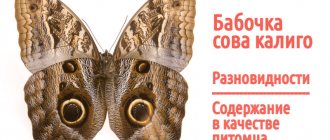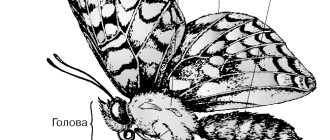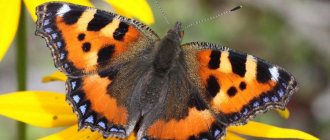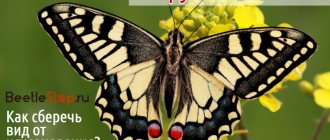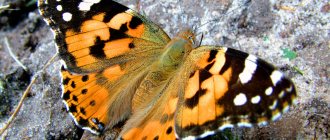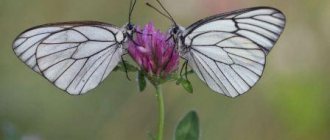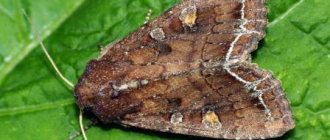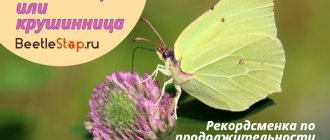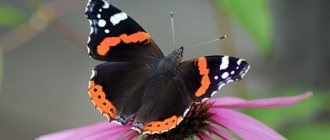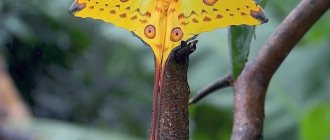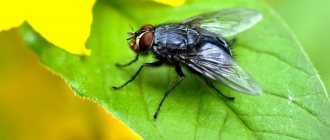Butterflies got their name “bear” from the appearance of their caterpillars, whose bodies are covered with dark, long hairs. These caterpillars really resemble small bear cubs in appearance.
Dipper butterflies are perfectly protected from enemies: their blood is poisonous and bitter, and in addition, the bear has a frightening coloring. Caterpillars are also well protected; in addition to poisonous blood, they have poisonous hairs that provoke a severe allergic reaction in people.
Ursa butterflies come in medium to large sizes. As a rule, they are variegated and brightly colored. Their front wings are triangular in shape, wide and elongated. The wings are decorated with a pattern of stripes, lines and spots. The hind wings are not so variegated, yellow, red and pink. When the bear is in a calm state, her wings fold into a house.
Bear butterfly (Arctiidae).
Their body is thick and completely covered with hairs. The legs are hairy and short. The antennae are comb-like.
How to identify a caterpillar
Bear caterpillars prefer grasses and low-growing plants, but some live in trees.
The larvae are densely covered with hairs, the tips of which are white. They reach a length of 6 centimeters. The first instar larvae are covered with white hairs. If she senses danger, she falls to the ground and takes on a ring shape, pretending to be dead. The kaya bear caterpillar feeds on almost any herbaceous plants and shrubs. She especially loves raspberry, viburnum, heather, honeysuckle, and blackberry leaves.
After maturation, the larva pupates. During this period they hide in the soil, or rather in the forest floor. They will lie there all winter.
Reproduction
Caterpillar
In July, fertilized females lay eggs in large bluish-white groups on the undersides of leaves.
Caterpillar
The caterpillar stage is from September to May. The caterpillar hibernates. Length about 60 mm. The color is black, covered with long hairs with white tips. The first instar caterpillars are covered with gray hairs, with yellowish stripes on the back. When in danger, the caterpillar falls from the food plant to the ground, curls up and pretends to be dead.
Caterpillars are polyphagous, feeding on the leaves of various types of herbaceous and shrubby plant species. Main forage plants: raspberries, blackberries, viburnum, honeysuckle, heather, hogweed, gorse. They also feed on the leaves of such species as apple, strawberry, pear, etc.
Family Features
- The name comes from the caterpillars, which are distinguished by their hairiness. The body is covered with brown-black hairs. They are located quite close to each other, thereby imitating the skin of a bear. As a rule, most representatives of the species have hairs collected in bunches. They have a certain fit that imitates many moles (or warts).
- Thanks to their special cover, the caterpillars are protected from the crabs that live in their natural environment. They prefer to hide from predators; they eat grasses, lichens and mosses growing on trees.
- These representatives of the family are classified as large-sized. They have a dense body, medium or large sizes. Many individuals are variegated in color, while some may be monochromatic. The fore wings are larger than the hind wings and are triangular. Almost all individuals of this family are awake at night and in the evenings.
- The species is common in European countries right up to the border with Sweden. Lepidoptera representatives are found in Turkey, Asian countries, and in the vast expanses of our homeland. Most butterflies live in the Caucasus and the Urals.
Euplagia quadripunctaria (Poda, 1761)
System
class Insecta → subclass Pterygota → infraclass Neoptera → superorder Holobola → order Lepidoptera → superfamily Noctuoidea → family Erebidae → subfamily Arctiinae → tribe Arctiini → subtribe Callimorphina → genus Euplagia → species Euplagia quadripunctaria
Full title
Euplagia quadripunctaria (Poda, 1761) = Panaxia quadripunctaria = Phalaena quadripunctaria Poda, 1761 = plataginis Scopoli, 1763.
Ursa Hera, Ursa four-spotted
urn:lsid:insecta.pro:taxonomy:6692
Spreading
Zoogeographical areas
Palaearctic.
Regions of Russia
#1. Kaliningradsky; #9. European Central Black Earth; #10. Middle Volga; #eleven. Volga-Don; #12. Nizhnevolzhsky; #13. West Caucasian; #14. East Caucasian; #17. South Ural.
Front fender length
23-26 mm.
Primary colors
Red, Orange, Yellow, Brown/Gray/Black.
Summer time
| January | February | March | April | May | June | July | August | September | October | November | December |
Lifetime of the larva
| January | February | March | April | May | June | July | August | September | October | November | December |
Detailed information indicating sources
Synonyms and generic combinations
- Panaxia quadripunctaria. [85]. Peter Khramov.
Features of appearance and differences from similar species
- The length of the front wing is up to 2.6 cm. The general background of the wings is brown, with light yellowish stripes on the background. On the red hind wings there are a pair of round and one irregularly shaped black spots. [5]. Peter Khramov.
Spreading
- Austria, Albania, Belgium, Bulgaria, Great Britain, Hungary, Germany, Greece, Spain, Italy, Corsica, Crete, Latvia, Lithuania, Luxembourg, the Netherlands, Poland, Portugal, Romania, Sicily, Slovakia, USSR - European part, Turkey - European part, France, Czech Republic, Switzerland, Yugoslavia. [1]. Peter Khramov.
- Regions of the Russian Federation: Volga-Don, East Caucasus, European Central Black Earth, West Caucasus, Kaliningrad, Lower Volga, Middle Volga, South Ural. [3]. Peter Khramov.
- Austria, Albania, Andorra, Belarus, Belgium, Bulgaria, Bosnia and Herzegovina, British Isles, Hungary, Germany, Greece (Mainland), Denmark (Mainland), Dodecanese Islands, Spain (Mainland), Italy (Mainland), Cyprus, Corsica, Crete, Lithuania, Luxembourg, Macedonia, Moldova, the Netherlands, Channel Islands, Poland, Portugal (mainland), Russia, Romania, North Aegean Islands, Sicily, Slovakia, Slovenia, Turkey (European part), Ukraine, Finland , France (mainland), Croatia, Cycladic Islands, Czech Republic, Switzerland, Yugoslavia. [10]. Peter Khramov.
- Range: Europe - up to central Germany in the north, Russia - middle and southern parts. [5]. Peter Khramov.
Summer time
- From late July to August. [5]. Peter Khramov.
Additional information about the adult stage
- Limestone mountainous areas, as well as dry valleys with water sources, next to which dense vegetation is expected. Butterflies fly during the day. [5]. Peter Khramov.
Lifetime of the larva
- Euplagia quadripunctaria caterpillars live from September to June of the following year. [5]. Peter Khramov.
Food plants or other objects
- Lamium, Epilobium, Corylus, Rubus, Lonicera, Sarothamnus, Urtica. [28]. Peter Khramov.
- Laminaria, fireweed and nettle, hazel and raspberries (the last two in spring). [5]. Peter Khramov.
Additional information about the larva
- They manage to molt several times before the onset of winter. [5]. Peter Khramov.
Subspecies of Euplagia quadripunctaria
- E.q. fulgida (Oberthür, 1896).
- E.q. fulgida Oberthür, 1896.
- E.q. ingridae (Roesler, 1969).
- E.q. ingridae Roesler, 1968.
- E.q. latefasciata Bubacek., 1915.
- E.q. magna Spuler-Hofmann, 1910.
- E.q. quadripunctaria.
- E.q. rhodosensis (Daniel, 1953).
- E.q. rhodosensis Daniel, 1953.
- E.q. splendidior Tams, 1922.
- E.q. tkatshukovi Sheljuzhko, 1935.
We worked on the material
Primary addition of the species: Petr Khramov.
Photos: Igor Torgachkin, Igor Sakhno.
Text information: Petr Khramov.
Formalization of the main features: Petr Khramov.
Formalization of color characteristics: Petr Khramov.
Literature
- [1] O. Karsholt, J. Razowski (eds.), 1996. The Lepidoptera of Europe: a distributional checklist
- [3] Catalog of Lepidoptera (Lepidoptera) of Russia. Ed. S. Yu. Sineva. St. Petersburg; M.: Partnership of scientific publications KMK, 2008
- [5] Reichholf-Rim H. Butterflies. M.: Astrel, 2002
- [10] de Jong, YSDM (ed.) (2011) Fauna Europaea version 2.4 (faunaeur.org)
- [28] Moths and Butterflies of Europe and North Africa (leps.it), 2012
- [85] Lepidoptera.ru (Insecta.pro previous version / old version Insecta.pro)
Comments
Register on the site and/or log into your account to upload new posts and comments
* By default, the site administration is responsible for translating comments from Russian into English. If you want to preserve the author’s style as much as possible or simply make life easier for the translator, copy the text along with tags from the Russian comment window, paste it into the English window and replace the Russian text with English, keeping the tags.
Family Features
The family owes its name to caterpillars whose bodies are covered with long, dark brown hairs so thick that they appear to be dressed in bearskin. Most caterpillars of these butterflies have hairs collected in tufts-tassels, sitting on special protrusions-warts. This “fur coat” protects the bear caterpillars from enemies. Caterpillars lead a relatively secretive lifestyle, feed mainly on herbs, and in lichen bears they switched to feeding on mosses or lichens growing on tree trunks
Dippers are medium to large sized butterflies with a plump body. Large species of this family are very brightly and variegatedly colored, but many smaller species are gray and inconspicuous. The front wings are triangular in shape, the hind wings are smaller. Almost all female bears lead an evening and nocturnal lifestyle. Let's take a closer look at some of the most interesting species.
Kaya bear
One of the most famous representatives of the family is the female bear (Arctia caja). Its habitat includes Europe, Asia and North America. This species is common in central Russia, as well as in Siberia and the Far East. The wingspan of kaya is 6-7 cm. The upper side of the wings is colored in brown and white shades and has an irregular winding pattern, the hind wings are red-orange, with round black or blue spots.
The kaya's proboscis is underdeveloped, so it does not feed throughout its short life.
Ursa Hera
The bear, named after the wife of Zeus, the goddess Hera, is easily recognized by three oblique light lines on the front wings and black spots on the red hind wings. The Hera bear (Euplagia quadripunctaria) lives in Europe (except for the northern regions) and Central Asia. It is found on forest edges and clearings, among shrubs in the zone of deciduous forests. In terms of flight time, Hera is a late-summer species - these butterflies fly in July and August. Unlike most other bears, Hera flies during the day. The caterpillars of this butterfly hibernate.
Human economic activity is leading to the destruction of hera habitats, and today it has become extremely rare in many places.
Transcaspian gloomy bear
This is one of the largest representatives of the family - its wingspan often exceeds 10 cm! The species surprises not only with its size, but also with its way of life - the Trans-Caspian gloomy bears (Axiopoena maura) prefer to live among rocks and in caves! It is also unusual that the caterpillars of this species live very far from caves in mixed-grass steppes.
This amazing butterfly is found in India, Afghanistan, Pakistan, Iran, Transcaucasia and Turkmenistan
Lady bear
The lady bear (Callimorpha dominula), unlike the previous species, cannot boast of large sizes (its wingspan is only 4.5-5 cm), but it is very beautiful. The front wings are colored in dark shades with light spots, the hind wings are orange or bright red with dark spots.
The lady bear is widespread in Central and Southern Europe, the Caucasus and Transcaucasia. Prefers damp and open places - clearings, grassy slopes, ravines, clearings of deciduous forests.
Village bear
Distribution: in Europe, North Africa, in the Palaearctic zone up to India. Lives in light forests, bushes and meadows. Wingspan 50-65 mm. The length of the front wing is 25-30 mm. The color of the upper side of the wings is black and white with an irregular sinuous pattern, characterized by great variability. The upper side of the hind wings is yellow with black spots. The head and chest are dark, red-brown, the abdomen is red, with black dots in the center. Butterflies are characterized by polymorphism
Red-spotted bear
The red-spotted bear (Utetheisa pulchella) is a relatively small species, found in southern Europe, Africa, Central and South Asia. It got its name from the bright pattern on its wings. This rather rare species is mainly found in meadows.
Purple Dipper
The purple bear (Rhyparia purpurata) is found in Europe and temperate Asian regions. Settles on dry heather heaths and sandy soils. Its wingspan is 3-4.5 cm. The front wings are yellow, with individual brownish spots, the hind wings are orange-red.
Our planet is full of exciting mysteries. And it often happens that a person encounters objects or living organisms whose existence he had no idea about. And if earlier you had to turn to encyclopedias for answers, today Internet users will be happy to give answers to all questions.
Spreading
This species is distributed in the Holarctic region, mainly in the temperate climate zone. The plantain bear prefers to settle in mountainous areas at altitudes up to 3000 m above sea level. Optimal for it are hills with wet meadows or swamps and located on the edge of forests near rivers and streams. In Europe, the largest populations live in the Alps, Balkans and Pyrenees. They are most often observed where lupine or wolf bean (Lupinus) grows.
Butterflies are also found in Asia Minor, Transcaucasia, China, Korea, Mongolia, Japan and North America.
The North American population lives in the area from the Canadian province of Manitoba and Alaska in the north to the state of New Mexico. Isolated populations persist in the US states of Arizona, California and Nevada. Many of them have declined significantly since the mid-twentieth century after reclamation work and other changes in their biotope caused by human factors.
Kaya bear
Another widespread group of bears is the Kaya bear. These butterflies are very beautiful, and they are one of the largest in Russia, their wingspan reaches 80 millimeters.
We suggest you read: What do snakes eat at home?
The female bear kaya has coffee-brown forewings with white bands. The red hind wings have large black peas with a blue tint.
Kaya bears are found in late summer. The caterpillars are black and hairy. They appear in the fall and spend the winter. These caterpillars have a very thick covering of hairs, thanks to which they resemble furry animals. In times of danger, the caterpillar takes a protective position: it curls into a ring, thus protecting all its vital organs, and the body is reliably protected from enemies by thick poisonous hairs. When the caterpillars pupate, they hide under fallen trunks and stones and weave their cocoons there.
Danaid monarch
The monarch is a poisonous butterfly from the genus Danaeidae and the family Nymphalidae. In general, it is distributed in North America, where it is found from southern Canada to Mexico itself. However, the species has been spotted in other regions of the world, such as the Canary Islands, North Africa, Europe and Russia. Butterflies are known for their long-distance migrations to winter, during which they travel up to three thousand kilometers.
The Danaid Monarch has dark orange wings with thick black lines that follow the veining pattern. The outer edges of the wings are edged in black interspersed with white spots. Their caterpillars are colored with yellow, white and black transverse stripes.
Even at the larval stage, insects feed on the leaves of the swallowtail, which contains toxic substances - glycosides. Monarchs themselves do not react to the poison, but their bodies accumulate it in their tissues. After this, the caterpillars become inedible for most birds and small mammals. When pupating, they completely retain their toxic properties, so adult butterflies are also poisonous.
Why do butterflies strive for light?
The question of why moths fly towards the light interests many. Moreover, not only nocturnal varieties of moths, but also daytime ones can fly towards the beckoning rays, often by mistake. Although such a reaction is more often due to the fact that such individuals simply fell asleep near the light source, and when darkness fell and it turned on, they became frightened and rushed to escape.
According to recent studies, moths are increasingly less likely to seek light. This is due to the formation of special behavioral mechanisms in them that help them avoid harmful effects. Researchers used ermine moth caterpillars. These insects were raised until the first molt, half in suburban areas with a minimum of artificial lighting, the other half in areas where street lighting was maximum. As the results of the study showed, those butterflies that emerged from caterpillars that grew in places with bright lighting were 30% less likely to rush into the light than those that grew in areas with a minimum of light.
Blind Hawkmoth
Amazing creatures
Caterpillars and their butterflies are not always alike; the color does not at all match the color of the future moth. Some larvae have similar features - spots, streaks of identical color. Only specialists and obvious fans of these insects can determine from which caterpillars and which butterflies emerge.
- One of the most beautiful butterflies in our area is the peacock eye. The larva of this beauty is black in color with spines all over its body. The change in appearance is dramatic.
- Other black caterpillars will become wren butterflies.
- Amazing creation of bromeia. The caterpillar looks like a stick, and the butterfly has a very interesting woody color
- Green caterpillar with multi-colored pimples - cecropia.
- The black swallowtail has a simply irresistible color in green and blue tones. But there are also yellow dots on the caterpillar’s body.
- Dalcerida. It is not clear from the outside whether the larva will produce an insect or an animal. The appearance of the moth is no less unusual.
- The blue morpho is another creature that captivates with its appearance.
- Swallowtail is a butterfly well known in our area.
- The butterfly used to produce natural silk is the silkworm. She leads a sedentary lifestyle and practically does not use her wings for their intended purpose, despite the fact that their span reaches 60 mm. The larva forms a cocoon of silk threads up to 1500 m long.
We invite you to familiarize yourself with the buildings on the land plot
Peacock butterfly and its caterpillar
Do caterpillars that manage to survive to the pupation stage always turn into moths - yes. Transformation always happens. However, in nature there are other insects whose larvae are similar to caterpillars, but they are called worms. At the end of the development process, they are destined to turn into beetles, bees, flies, and wasps. Sawflies are very similar to the larvae of butterflies; they are called false caterpillars.
People never cease to admire some types of butterflies; they keep them in the house, creating favorable living conditions for them.
Butterflies and their caterpillars often differ in coloring, so it is quite difficult to understand at the caterpillar stage which moth it will turn out to be. Despite this, some similarities can be found on the body of the caterpillars, in the form of spots or streaks. Therefore, only specialists who study these amazing living creatures know which caterpillars belong to which butterflies.
Below are photos of butterflies and caterpillars, as well as their names.
- The peacock eye is one of the most beautiful and most common butterflies that can be found in our area. The caterpillar of this butterfly is black in color and has many spines on its body. It should be noted that there is a fundamental difference between a butterfly and its caterpillar.
- Black caterpillars similar in appearance will turn into butterflies - hives.
- Bromeas are quite interesting creatures, since the caterpillar has a stick-like appearance, while the butterfly has an interesting woody hue.
- The Cecronia butterfly comes from a green caterpillar that has multi-colored pimples on its body.
- The black swallowtail is distinguished by an amazing green-blue tint, while there are also yellow dots on the caterpillar’s body.
- Dalcerida is such a unique creature that it is not clear what kind of creature will come out of the caterpillar. The moth also has an unusual appearance.
- The blue morpho is a species of butterfly that has a rather attractive appearance.
- Swallowtail is a butterfly that is often found in our area.
- Silkworm. Thanks to this butterfly, man managed to obtain natural silk. When a butterfly larva forms a cocoon, the length of the thread is about one and a half kilometers. The butterfly rarely flies, despite the fact that its wings reach a span of 60 mm.
Peacock butterfly
There are species that are so beautiful and unique that people keep them in their homes, creating favorable conditions for them.
How does a caterpillar turn into a butterfly? | DeeAFilm
Number and trends of its change
In the Oka part of the region it is stated as local and in places (or at times) not uncommon, in the south - as a very rare species. In the Tula region. at least 20 key habitats with an area of several tens of hectares are known, 5 of which form 2 system-forming habitats with an area of several hundred hectares each; in another 3 places in the central part of the region (in the south of Yasnogorsk (1 copy each, 1979 and 2002) and in Leninsky (1 copy, 2009) districts, the presence of cenopopulations requires clarification. Some habitats in outwash ecotopes could increase in the 1990s due to a reduction in economic activity. In most places, from single to several dozen butterflies and single caterpillars were regularly observed. The density of adults in coenopopulations in favorable xerothermic stations can reach 5-7 ind./ha, in mesophytic stations it is significantly below.
Area
Species range: Central and Southern Europe (except for the southern part of the Iberian Peninsula, Western France, the coasts of the Baltic and North Seas, the Alps and the south of the Balkan Peninsula), the European part of the former USSR north to Southern Lithuania, Kaluga, the lower reaches of the Kama; Transcaucasia, Asia Minor, Iran, Kazakhstan, eastern Central Asia, Western Siberia to the north to Kurgan, Omsk and Novosibirsk; Western Altai, Tuva, southern Transbaikalia, Mongolia, China, including Inner Mongolia. In Russia it is found in the south of the European part of the country, Siberia, and the Caucasus. In addition, the range includes Crimea, Central Asia and Kazakhstan.
Description
It acquired such an unusual name as pear peacock eye due to its incredibly unusual color. Each of the four wings is endowed with a beautiful large eye-shaped spot. It is precisely the same spots that can be found on the plumage of such a majestic bird as the peacock.
Caterpillars weave their cocoons exclusively on fruit-bearing trees and shrubs. Most often they can be found on pears. Perhaps the name peacock eye was given to it precisely because when the caterpillar curls up into a cocoon, it looks quite similar to a pear.
Large peacock eye, one of the largest butterflies living in the European part of the globe. Each wing is approximately 6–7 cm in size, so the total length of the insect is about 15–16 cm. This is quite a long length for an insect such as a butterfly. It is rare to find a larger Saturnia in nature, but there are such cases. At night, flapping its wings, a large peacock eye can easily be confused with a small bat. The body of the butterfly itself is large, like the wings, and also has a noticeable fur edge. Females differ from males in the length of their whiskers.
Males have antennae:
- Great length.
- Cirrus.
- They have many branches.
- Wide.
- Constantly swaying.
Females have antennae:
- Small ones.
- More like scallops.
Proper nutrition in the peacock eye is disrupted because the proboscis, through which the insect feeds, has an underdeveloped structure. The butterfly feeds on internal resources that were able to be deposited while it was in the caterpillar stage of development.
The color of Saturnia is usually gray with brown spots. Clearly defined stripes and spots on the wings of the insect are clearly visible. The color of the peacock eye is also unusual in that it has a light cream-colored edging at the end of its wings.
Message 2
The mourning butterfly acquired its name due to its dark and mourning coloration.
The top of the wings has a brown-cherry tint with a white or yellow border. The wings have blue spots with a black rim. The lower part of the wings is black and gray. They have small fur over the entire surface of the wings and body.
The butterfly is of medium size and its wingspan reaches 70-90 centimeters.
The mourning butterfly belongs to the nymphalidae family.
The color of the butterfly may depend on temperature changes during the development of the pupa. Sudden changes and drops in temperature can cause darkening of the wings and the disappearance of blue spots.
Lifestyle
The mourning butterfly begins an active lifestyle in April; it can be seen with the first rays of the warm sun.
The butterfly can be seen throughout the summer. The mourning bird lives in Asia, Europe, North America and Japan. It can also be found in Germany, England and Norway.
For life, the butterfly chooses meadows, forests, river banks and even mountains (no higher than 2000 meters above sea level).
Nutrition
Feeding on nectar is not typical for the mourning butterfly. The butterfly liked the fruits that had begun to rot, and was attracted by the smell of fermentation.
The butterfly needs more liquid. Due to this, she will not be able to live away from the reservoir. The mourner can often be seen drinking the sap of birch and other plants. Caterpillars can be found on fruit trees and bushes. Also, the mourning plant can be found in the field on the weeds.
Butterfly breeding
When the mating season begins, males begin to choose clearings and wait for females there. Males feel competition, and they protect the territory from rivals.
A fertilized female can lay up to 100 eggs. Lays on tree branches or leaves.
Already in the spring you can see an invasion of caterpillars on a tree. They are not large in size when hatching (up to 2 millimeters). The caterpillars stay in a heap, and only when closer to pupation do they begin to spread out.
The cupola clings to the leaves upside down. The pupal stage can last 10-12 days. The mourning bird only goes through one cycle during the summer and does not hibernate for several weeks.
The mourning butterfly is not like other types of butterflies. It has a peculiar color that depends on the temperature. Their diet and habitats differ from the lifestyle of other representatives of these flying individuals.
Notes
Arctia (lat.) is a genus of moths from the subfamily of bears of the erebid family, common in the Holarctic region.
Ábashar (Hungarian: Abasár) is a village in Hungary, in the Northern Hungary region, in the Heves County, in the Gyöngyös Jarás. The main settlement of the Matra wine region. The highest viticultural area in Hungary, Mount Sárhegy, is located here.
The Red Book of the Pridnestrovian Moldavian Republic is an official document containing a set of information on the status and distribution of rare and endangered species (subspecies, populations) of wild animals and wild plants and fungi living (growing) on the territory of the Pridnestrovian Moldavian Republic, as well as the necessary measures for their protection and restoration.
The Olschwangi bear (Arctia olschwangi) is a butterfly from the bear family. The specific name was given in honor of the Soviet and Russian entomologist, member of the Russian Entomological Society Vladimir Nikolaevich Olshvang (born 1946).
Butterflies are often brightly and variegated in color, hairy, with a thick body and b.m. large; small species b.h. not brightly colored, not furry and with wider wings. The antennae are short, and in males they are often combed; the eyes are bare (rarely covered with small cilia), the legs are relatively short.
Butterflies often lead a nocturnal or twilight lifestyle. Some species, such as the meadow bear Diacrisia sannio L. and the red-spotted bear Utetheisa pulchella L., are active both during the day and at night. Other species, for example, striped bear Spiris striata L., Kindermann's bear Sibirarctia kindermanni Stgr.
Caterpillars are hairy, in most species they often develop on a large number of different types of herbaceous plants, lichen species - on lichens and liverworts. Many species of the genus Spilarctia Btl. prefer to feed on the foliage of various trees. Pupation usually occurs on the ground in the forest floor in a light cocoon.
Among the bears there are very large species, for example, the gloomy bear with a wingspan sometimes exceeding 11 cm. Among the smallest species of real bears are Epimydia dialampra Stgr. (mountains of Southern Siberia and Mongolia) with a wingspan of less than 2.5 cm. Representatives of lichens are much smaller.
Some species, for example, the red-spotted bear Utetheisa pulchella L., have a very wide distribution - from the islands in the Atlantic Ocean in the west to Myanmar (Burma) in the east; this species sometimes makes long-distance migrations to the north, for example, to Lake Onega. Among the narrowly localized species are endemics of South-Eastern Altai and South-Western Tuva: Dodia sazonovi Dubat., Holoarctia dubatolovi Sald., Palearctia mira Dubat. et Tshist.
There are about 11,000 species known in the world. In Russia there are 73 species of the subfamily Arctiinae, 66 - Lithosiinae, 11 - Syntominae. In the European part of Russia, including the Caucasus and the Urals, there are 42 species of the subfamily Arctiinae, 22 - Lithosiinae, 8 - Syntominae. The greatest diversity of bears (even without lichens) is in South America, where more than 5 thousand species of these butterflies are known.
The fauna of the Faroe Islands is characterized by the remote location of the islands in the North Atlantic Ocean. The Faroe Islands have very few terrestrial species, but relatively many breeding seabirds and marine animals. Some subspecies and variations are endemic. All land mammals were brought to the Faroe Islands by humans. Before the arrival of man, there were no land mammals on these islands.
Sources
- https://tapi-tapi.ru/gusenitsa-medveditsy-pitaetsya/
- https://FB.ru/article/257115/babochka-medveditsa-osobennosti-rasprostranenie-foto
- https://matushka-priroda.ru/blog/nasekomye/2019-02-01-babochka-medvedica.html
- https://apest.ru/nasekomye/babochki/vidy-babochek-i-gusenits/gusenitsa-medveditsi/
- https://www.krasnouhie.ru/babochki-medvedicy.html
- https://ru.wikihow.com/%D1%83%D1%85%D0%B0%D0%B6%D0%B8%D0%B2%D0%B0%D1%82%D1%8C-%D0% B7%D0%B0-%D0%B2%D0%BE%D0%BB%D0%BE%D1%81%D0%B0%D1%82%D0%BE%D0%B9-%D0%B3%D1% 83%D1%81%D0%B5%D0%BD%D0%B8%D1%86%D0%B5%D0%B9-%D0%BC%D0%B5%D0%B4%D0%B2%D0%B5 %D0%B4%D0%B8%D1%86%D1%8B
Subspecies
Yellow form f. flava
- Callimorpha dominula dominula (Baltic states, Ukraine, Moldova, Western Russia, Europe except south and north)
- Callimorpha dominula lusitanica (Portugal)
- Callimorpha dominula pompalis (Southern Alpine valleys)
- Callimorpha dominula persona (Italy, areas south of the Alps)
- Callimorpha dominula trinacriae (Sicily)
- Callimorpha dominula profuga (Balkans, Western Türkiye)
- Callimorpha dominula rossica (Caucasus, Transcaucasia, Northwestern Iran)
- Callimorpha dominula philippsi (Azerbaijan (Talysh), Northern Iran, Southern Turkmenistan)
- Callimorpha dominula kurdistanica (Southeastern Türkiye, presumably Northern)
Family Features
All female bears are relatively large in size. They have a plump body. The front wings are triangular in shape and in most species are brightly colored. The hind wings are smaller and often have a modest coloration. A calm or resting bear butterfly folds its wings like a house, hiding their brightness.
An important feature shared by the entire family is toxicity. The blood of these butterflies has a bitter taste - this is for those who did not understand the signal of the motley wings and still decided to attack. Most poisonous creatures look striking, as if warning predators about their peculiarity. It is difficult to digest such prey; it can cause irritation in the digestive system or allergies.
Young people are no less protected. Not only does the bear butterfly caterpillar have bitter, poisonous blood, but its hairs also secrete a strong irritant. Not only should you not chew it, but you shouldn’t even touch it. Thanks to this feature, both adult butterflies and caterpillars have virtually no natural enemies.
What is first aid?
After contact with poisonous butterflies, a person develops redness on the skin; the poison can cause itching and burning. In case of severe poisoning, or severe sensitivity of a person to this allergen, the temperature may rise, nausea, and muscle soreness may appear.
If a painful condition occurs as a result of contact with one of the poisonous beauties, you must:
- apply ice to the point of contact, which will slow down the blood flow and prevent the spread of toxins throughout the body;
- apply a constricting bandage that will limit the spread of poison through the bloodstream;
- treat the open wound with a bactericidal agent;
- Give the patient an antihistamine.
A person suffering from allergic reactions should always have histamines with him when going on vacation anywhere.
Literature
- Mikrula. Photos of a butterfly.
- M. P. Cornelio. School atlas - identification of butterflies. M., Visit. 1986.
- Biology. 7th grade. V. M. Konstantinov, V. G. Babenko, V. S. Kuchmenko, Ventana-Graf, 2009.
- P. Marikovsky “To the young entomologist.” M.: Children's literature, 1978.
An Indonesian posted on his Facebook a video of a strange-looking creature that looked like a hybrid of a moth and a spider with furry legs. Commentators write that they would rather burn down their house than be near this creature. True, it turned out that this is not a monster from another planet, but a very ordinary insect before mating.
An Indonesian resident, who calls himself Gandhik on Facebook, tickled the nerves of his subscribers by sharing on Facebook a photo of a strange creature that looked like a butterfly from another planet.
After seeing the picture, people did not understand why this creature was still not on fire. Although, as the experience of a woman from Kansas shows, this is true.
“WHAT THE HELL IS THIS AND WHY IS IT STILL NOT BURNING?”
“OH GOD NO, I WILL BURN THE WHOLE COUNTRY WHEN I SEE THIS CREATION.”
People did not understand what kind of creature was in front of them, but they guessed that it was a hybrid of a spider and a moth. Or moths with caterpillars. Most people didn't want to face him anyway.
“I’d rather be dragged into hell than face this.”
“I’ll have to be revived if I step on this.”
For those who have very strong nerves, there was also a recording attached to the post where a mysterious creature moves its paws.
The video captured a bear butterfly (in Latin the name sounds like Creatonotos gangis). According to the Daily Mail, such hairy legs on these insects cannot always be seen, but only during the mating period.
With the help of these tubes - coremates filled with blood or air - male butterflies secrete pheromones. The hairs, of which there are about 3 thousand on each tube, help distribute these odors.
The size of the coremates depends on how many leaves of poisonous plants the male ate when he was a caterpillar.
But even when Facebook users found out what kind of creature was in front of them, their sympathy for him did not increase.
“Yes, it’s worse than a spider.”
"It's horrible!!! Why does this exist?!!! I would leave wherever it was and never return.”
Such butterflies are found in Asia and Australia, and now people doubt whether to go to this country. After all, there you can also stumble upon fluffy spiders, which at first glance...
“Look, honey, this is why we don’t have to go to Australia.”
But it’s not just insects that give Internet users nightmares; sea creatures can also give spiders and bear butterflies a run for their money. This fisherman from Murmansk regularly posts photos, and subscribers can’t tear themselves away from them.
A set of problems for the full-time round of the school stage of the Olympiad for grade 8
Problem 8-1
Who seeks will always find!
At the beginning of the twentieth century, geologists encrypted the discovery sites of valuable metal ores on maps using the coordinates of chemical elements in the Periodic Table. The Arabic numeral indicated the period number, and the Roman numeral indicated the group number. In addition, the records also contained letters of the Russian alphabet - A and B. On one of the old maps they found the following designations: 4VIB, 4VIIIB2, 6IB, 6IIB. Exercise:
Decipher the geologists' notes.(2 points)
Problem 8-2
A light body that can be forged. M.V. Lomonosov
One of the chemical elements was isolated back in the 16th century. German chemist and metallurgist Georgius Agricola. In Ruland’s “Alchemical Dictionary” (1612) it is classified as a metal and called “the lightest, palest and cheapest lead.” In Russia they called him either “nymph” or “glaura”. The origin of the modern name is also shrouded in mystery. Some believe that it comes from the Arabic words “bi ismid” - similar to antimony. Others suggest that the name of the element is of ancient Germanic origin and means “white metal.” Still others claim that the name comes from two German words - “wiese” (meadow) and “muten” (mine), since in German Saxony the element has long been mined in mines located among the meadows of the Schneeberg district. Exercise:
What is this element? Describe its position in the Periodic Table. Determine the composition of the highest oxide of this element.
Problem 8-3
An accurate logical definition of concepts is a condition for true knowledge. Socrates
Suggest various options for classifying these inorganic substances:
CO 2, NO, NO 2, Na 2 O, Al 2 O 3, SiO 2, P 2 O 5, Cr 2 O 3, CuO, ZnO
Problem 8-4
A good idea is made up of many small ideas. Thomas Edison
Offer several options (no more than three) for solving the chain of reactions A → B → C and create reaction equations for this scheme. Substances A, B, C are complex inorganic compounds belonging to different classes of compounds. (6 points)
Problem 8-5
A scientific hypothesis always goes beyond the facts that served
basis for its construction. Vernadsky
Decipher this chain of reactions, create reaction equations for it (all substances in the chain contain iron atoms): 56 → 127 → 90 → 72 → 56 (11 points)
Problem 8-6
All salts consist of some kind of acid and some kind of alkali... German chemist and pharmacist O. Tacheny
Give examples of salts whose reactions with acids and alkalis release gaseous products. Write the reaction equations in molecular and ionic form.
Problem 8-7
Q.E.D. Euclid
The bottle, cylinder, flask, and jar contain magnesium, barium hydroxide, copper (II) sulfate, and sulfuric acid. Magnesium and copper (II) sulfate are not in the bottle; the vessel with barium hydroxide is placed between the flask and the vessel with sulfuric acid. There is no barium hydroxide or glitter in the jar. The cylinder stands near a vessel with a blue substance.
Assignment: Find out the contents of each vessel. Make up equations for the reactions that occur when the contents of these vessels are mixed in pairs. (14 points)
Caterpillars
codling moth
The main goal in the life of a caterpillar is food. They eat, as a rule, the green parts of plants, which are richest in nutrients. Others feed on fruits by sitting inside them, such as the well-known codling moth. And some have adapted to eat wood, wool and even wax.
Gypsy moth
Caterpillars eat a lot. Their body weight can increase 50,000 times. Since the caterpillar's body covers do not stretch well, the larvae molt several times during their lives, completely shedding their old skin. Some caterpillars can feed only on one specific type of plant, while others can feed on a wide variety of plant species, such as the gypsy moth or the American white butterfly, which are capable of eating the leaves of more than 300 species of trees and shrubs. Many caterpillars are able to secrete webs made of protein through their mouths. Some do this in huge quantities, weaving a cocoon from silk or coarser fibers - chesuchi. To obtain silk thread, people have been raising silkworm caterpillars since ancient times. The cocoon made by the caterpillar unwinds, resulting in a thin silk thread up to 1.5 km long.
Nowadays, butterflies are bred not only for silk. The population of many tropical countries lives by breeding the largest and brightly colored species for the manufacture of various crafts, paintings, panels of wings, and boxes of dried butterflies. The auction value of some rare specimens can reach several thousand dollars. But most of the butterflies sold continue to be caught in the wild, which, together with the constantly shrinking natural areas of their habitat, leads to a decrease in the number of these beautiful and often useful insects.
Control measures
When the first signs of the American butterfly appear in the garden, urgent measures must be taken to destroy it. It is recommended to use comprehensive control measures.
Mechanical method
First of all, it is necessary to remove the spider nests of caterpillars from the tree and burn them. This procedure must be done regularly at least once a week to prevent mass reproduction of the American white butterfly.
In late autumn, loose areas of bark and fallen leaves under the trees should be removed. All this plant litter must be burned, as the pupae of the American white butterfly can overwinter in it.
Nest
The pest should also be controlled in the spring. At this time, it is necessary to install trapping belts for individuals wintering in the soil. The mechanical method of control also involves collecting the caterpillars of the American white butterfly when they gather in groups after rain or at night.
Biological method
Special biological products that can be used throughout the growing season also help to cope with the problem. These include Bitoxibacillin, Lepidocid.
They are based on viable spores that have a detrimental effect on the pest larvae. After eating the treated leaves, the caterpillars stop moving, turn black and die. The disadvantage of biological products is that they are washed off by rain, and in case of mass reproduction they are not able to eliminate the problem.
Folk remedies
To combat the American butterfly, you can also use folk remedies. One of them is to place barrels filled with water every 10 cm under the affected tree. Black hoses 1.5 m long should be hung along the edges of them. During hot periods, the caterpillars descend to the water and look for a secluded place for pupation , crawl inside the hoses. Subsequently, they need to be retrieved and destroyed.
Also, to combat the pest, you can hang containers half filled with beer on tree branches, as its smell attracts the larvae.
Chemicals
To destroy the American white butterfly, it is necessary to use chemicals. It is recommended to spray trees with them before flowering begins and after it, as well as during the period of fruit formation, but taking into account the waiting period before harvesting.
Effective remedies against this pest:
- Chlorophos;
- Sevin;
- Dursban 480;
- Rogor S;
- Entobacterin;
- Karate 050EC;
- Pirinex 40.
What do bears look like?
The body of the butterfly is somewhat thickened. Large species have very bright wings, covered with hairs, like wool. Small varieties are inconspicuous, their wings are wider, and their body is not covered with hairs. The eyes can be either bare or covered with small eyelashes. There are antennae on the head, and in males they are often comb-shaped.
The butterfly's head is dark, there are black transverse stripes
It is important to note that each representative has its own unique pattern on the wings. Moreover, this does not depend on living conditions. Sometimes insects living nearby are so different from each other in color that doubts arise about their relationship
Sometimes insects living nearby differ so greatly in color from each other that doubts arise about their relationship.
Most often the bear insect can be found at night. However, the meadow and red-spotted butterflies are active at any time of the day. The striped bear likes to collect nectar only during the day; you cannot find them at night. But Ménétrier feeds only in the early morning, when the sun has not yet risen. At night, she is not attracted even by bright sources of light.
The size directly depends on the type of insect. The largest is the gloomy bear. With a full wingspan, its dimensions reach 11 centimeters. But the tiniest butterfly will be Epimydia dialampra Stgr. with wings up to 2.5 cm in size. In total, more than 11 thousand species of this insect are known. At the same time, up to 42 species of true bears and 22 species of lichens can be found on the territory of Russia. The most diverse representation in South America.
Habitat area
Mole crickets live throughout the European part of Russia, with the exception of the northern regions; they can also often be found in Central Asia and the Caucasus. In addition to the common mole cricket, Gryllotalpa africana is also found in Russia. This species lives in the Ussuri region; it is also found in African countries, in India and China. In the summer months, mole crickets dig tunnels 10-20 cm deep from the surface of the earth, and in the winter this insect burrows deep into the soil, to a depth of 1 m.
The mole cricket lives in floodplains of rivers, where this insect is not afraid of floods, because mole crickets not only move well underground and fly, they also swim quite well. Mole crickets love moist soil, so they can often be found in vegetable gardens, greenhouses and greenhouses. This insect appears on the surface more often in the evening and at night, since during the day it hides underground.
Ursa butterfly and its most common varieties
The bear's caterpillar has no less attractive appearance than its butterfly. However, behind the external beauty lies the presence of a dangerous poison that can harm human health. These caterpillars do a lot of damage to the plant world, so often owners of gardens and vegetable gardens have to look for ways to combat them. They are very voracious and feed on the leaves of most garden trees and crops.
Family Features
All female bears are relatively large in size. They have a plump body. The front wings are triangular in shape and in most species are brightly colored. The hind wings are smaller and often have a modest coloration. A calm or resting bear butterfly folds its wings like a house, hiding their brightness.
An important feature shared by the entire family is toxicity. The blood of these butterflies has a bitter taste - this is for those who did not understand the signal of the motley wings and still decided to attack. Most poisonous creatures look striking, as if warning predators about their peculiarity. It is difficult to digest such prey; it can cause irritation in the digestive system or allergies.
Young people are no less protected. Not only does the bear butterfly caterpillar have bitter, poisonous blood, but its hairs also secrete a strong irritant. Not only should you not chew it, but you shouldn’t even touch it. Thanks to this feature, both adult butterflies and caterpillars have virtually no natural enemies.
Lifestyle
The favorite habitats of Callimorphadominula are mixed or sparse deciduous forests. They often settle in bushes, along road ditches, and on the banks of streams.
Butterflies become active after dark. During the day they hide in damp, shady places.
But there are exceptions to the rules; sometimes adults can be seen during the day, when moths fly over flowers, collecting nectar from umbrella plants.
The moths fly in June-July. The species is sedentary; males and females do not spend much time looking for a partner.
After mating, eggs are laid on the main food plants of the caterpillars:
- stinging nettle;
- jasmine;
- buttercup;
- geranium.
There are several subspecies of Callimorphadominula living in Europe and Asia:
- C. d. philippsi – Azerbaijan, northern Iran;
- C. d. rossica – Caucasus. Transcaucasia;
- CD persona – Italy.
These are just a few subspecies. Also interesting is the yellow form of the female bear f. flava.
Defense mechanism
The species has a weak flight, so catching a moth is not difficult. At the same time, they do not have many natural enemies. This is due to the presence of poison in the body of insects.
The hemolymph of the imago is bitter; not many birds and reptiles like it. The protective mechanism is present not only in adult representatives of the species, but also in larvae. Long and thick hairs are a decoration, and a kind of shield from predators.
Information. The bright colors of the wings warn animals about the danger of the lady bear to their health.
Caterpillar
Before turning into butterflies, caterpillars have to do a lot of work and perform an important task - to eat for future use. Therefore, they are omnivorous and gluttonous. Caterpillars eat shrubs and herbaceous plants, and tree foliage. This harms the plants.
Before pupation, the caterpillar spins a loose, silky cocoon. She weaves her own fallen hairs into the walls. The pupa inside the cocoon is motionless.
Life cycle
How long do moths live? The life cycle of these insects deserves close study; it can be divided into several successive stages:
- Eggs are laid by these moths either in the form of heaps or individual specimens. Moreover, females are able to lay them directly during flight, place them on objects or in vegetation tissues.
- After the allotted time, caterpillars emerge from the eggs, having a head, three pairs of legs with marigolds on the chest, and five pairs of legs on the body. After surviving periods of molting, the caterpillars are enclosed in a cocoon called a pupa. In it, the individual cannot move; the paws are tightly pressed to the body.
- After a while, an adult moth emerges from the pupa.
Lady bear
In the middle zone, the lady bear butterfly is very common. It is quite large, its wingspan reaches 5.5 cm.
Mole cricket reproduction
Mole crickets begin to reproduce in the spring, after a mass exit from wintering. Their fertilization is spermatophore, like other representatives of Orthoptera. Mating takes place underground. Offspring appear in summer.
For their offspring, insects prepare a home: they dig complex, densely branched labyrinths around the roots of plants and, at a shallow depth (5-10 cm from the surface), arrange spherical nests about 10 cm in diameter. Individuals of both sexes take part in this process. Inside the ball there is a nesting chamber the size of a chicken egg, the walls of which are well compacted. There, the female mole cricket lays from 300-350 to 600 eggs. This is a very important period for the survival of insects, because the offspring located underground are completely dependent on temperature and humidity. The female does not leave the nest, guarding it, maintaining ventilation and temperature. To do this, she clears the passages from the ground, eats up the roots of plants that cast a shadow on the nesting site. Mole cricket eggs are similar to millet grains: oval, yellowish-gray, 2 mm in size.
After 10-20 days, depending on the soil temperature, gray, six-legged, wingless larvae (nymphs) emerge from the eggs, which live in the nest under the protection of the female for 20-30 days. At the end of this period of time, the female begins to freeze and after some time dies. After this, the mole cricket larvae crawl away, dig separate holes and begin to feed.
The development of larvae takes a long time, with incomplete transformation. This period differs in different regions. In the south they develop within 1-2 years, in the north 2-2.5 years. The mole cricket larva is similar to the adult, but with smaller sizes, underdeveloped wings and genitals. In the early stages of development, they are very mobile, nimble and jump well, like grasshoppers. During the period of development from larva to mature adult, mole crickets molt 8-9 times.
Larvae of the common mole cricket. Photo by: Roman Špaček
Breeding at home
For breeding butterflies, choose a spacious container with a lid through which oxygen will pass. Cover the bottom with sphagnum moss, under which soil is placed. The height of the flooring is up to 2 cm. A frequent guest of such insectariums is a fluffy caterpillar, the name of which depends on its appearance.
For example, if you have a black hairy caterpillar, what is it called, it is not difficult to find out. If there are yellow dots, it's a mistress. If not, it is most likely urticaria. The furry black and orange creeper belongs to the kaya. It is interesting to watch how a black furry caterpillar pupates; what kind of butterfly will appear in the end will essentially become clear after 8 months.
In order for the insect to hibernate, the temperature drops to +3/+6 °C. Before this, she is fed fresh leaves. Once the pupa emerges, access to light is limited until hatching. After the butterfly appears, cotton wool soaked in a honey solution is used for feeding. As a result, a bear butterfly will appear, the photo of which will become your pride.
kaya (lat. Arctia Caja)
Arctiidae species
The bear butterfly is named by its basic Latin name Arctiinae, which means “bear” in Russian.
Species living in Russia:
- Hebe (lat. Euplagia quadripunctaria);
- speckled (lat. Utetheisa pulchella);
- yellow (lat. Epbestris melfntba);
- nettle (lat. Spilosoma lubricipeda);
- mole cricket (lat. Spilarctia luteum);
- kaya (lat. Arctia Caja);
- mistress (lat. Callimorpha dominula).
The common bear butterfly looks like a moth covered with dense hair. In the area of the head the hairs are longer. The furry caterpillar gives the name to the entire species. The female kaya bear's caterpillar is covered with brown fur. The black fluffy caterpillar with yellow dots belongs to the lady bear. The yellow bear has a fluffy red caterpillar with dense reddish bristles.
What do butterflies eat?
Some time after the transformation from a pupa to a butterfly, it destroys all the protein in its reserves and goes in search of food.
All butterflies have a proboscis - long and mobile, which is formed from elongated and modified jaws; it is this that allows them to suck nectar from flowers or juice from crevices in trees and fruits. If the butterfly is ready to eat, its proboscis, which is always curled, unfolds, allowing it to feast on something or drink water.
A butterfly that flies from flower to flower in search of food also pollinates plants. This occurs by transferring pollen on stalks from one specimen to another.
What do moths eat:
- fruit juice;
- juices of various plants;
- rotting fruits and vegetables;
- sweet substance secreted by aphids;
- bird excrement;
- flower nectar.
Methods of food absorption may vary among different subspecies of night beauties.
- Large swallowtails flutter their wings while drinking, hovering over the plant, and only slightly touch the petals with their limbs. Therefore, space is important for them, so that nothing interferes with the unfolded wings in movement.
- Hawkmoths also hover in space, like hummingbirds; they never land on a flower or touch the corolla.
- Other species traditionally sit on the flower and leisurely enjoy the sweet nectar. At the same time, their luxurious wings are folded.
They feed mainly on nectar from flowers
Swallowtail protection
On the territory of the Russian Federation, depending on the region, there is a low or average number of swallowtails. In the Vologda, Moscow and Smolensk regions, this species is at the stage of extinction, so it is listed in the Red Book. The factors that cause a decrease in the number of butterflies are economic and natural. The latter include unfavorable climatic conditions - low temperature and cloudy weather during mating and laying eggs, damage to autumn larvae by rain and fungal diseases, the influence of early frosts that kill the pupa at the stage of transformation into an adult.
But humans also bring a lot of harm to the swallowtail. Frequent fires in forests and burning of grass lead to the death of butterflies. They also die due to the treatment of agricultural land with insecticides and the capture of individual individuals for collecting. Caterpillars that feed on crops are also destroyed.
A reduction in the number of swallowtails is observed not only in Russia, but throughout Europe. The insects are protected in Latvia, Lithuania and Germany. In these countries, it is prohibited to catch butterflies and collect their caterpillars and pupae. There is strict control over the regularity of cattle grazing and the use of chemicals for treating plants.
There are several interesting facts about this type of insect:
the Germans decided to draw attention to the endangered species and in 2006 made the swallowtail a symbol of the state; colored eyes and tails on the wings are necessary to distract the attention of birds of prey from vital organs; at the end of August, the patterns on the insect’s body fade and become faded; at the slightest alarm, the butterfly begins to quickly flap its wings, trying to fight off the attacker; The intensity of the color directly depends on the climate: the higher the air temperature, the brighter the swallowtail will be.
Butterfly development: four stages of the life cycle
So, butterflies are insects with complete transformation - they have all four stages of the corresponding life cycle: egg, pupa, caterpillar larva and imago - an adult insect. Let us consider sequentially the stages of transformation in butterflies.
Egg
First, the adult butterfly lays an egg and thereby gives rise to a new life. Depending on the type, eggs can be round, oval, cylindrical, conical, flattened and even bottle-shaped. Eggs differ not only in shape, but also in color (usually they are white with a green tint, but other colors are not so rare - brown, red, blue, etc.).
The eggs are covered with a dense hard shell - the chorion. The embryo located under the chorion is equipped with a supply of nutrients, very similar to the well-known egg yolk. It is by this that the two main life forms of lepidopteran eggs are distinguished. Eggs of the first group are poor in yolk. Those species of butterflies that lay such eggs develop inactive and weak caterpillars. Outwardly, they look like tadpoles - a huge head and a thin, thin body. Caterpillars of such species must begin to feed immediately after emerging from the egg, only after which they acquire fully plump proportions. That is why butterflies of these species lay eggs on a food plant - on leaves, stems or branches. Eggs placed on plants are typical for diurnal butterflies, hawk moths, and many cutworms (especially lancets).
Cabbage butterfly eggs
In other butterflies, eggs are rich in yolk and provide the development of strong and active caterpillars. Having left the egg shell, these caterpillars immediately begin to crawl away and are able to cover sometimes quite significant distances for them before finding suitable food. Therefore, butterflies that lay such eggs do not need to worry too much about their placement - they lay them wherever they need to. Thinworms, for example, scatter eggs on the ground in bulk right on the fly. In addition to slender moths, this method is typical for bagworms, glassworts, many moths, cocoon moths and bear moths.
There are also lepidoptera that try to bury their eggs in the ground (some cutworms).
The number of eggs in a clutch also depends on the species and sometimes reaches 1000 or more, however, not all survive to the adult stage - this depends on factors such as temperature and humidity. In addition, butterfly eggs have no enemies from the insect world.
The average duration of the egg stage is 8-15 days, but in some species the eggs overwinter and this stage lasts months.
Caterpillar
A caterpillar is the larva of a butterfly. It is usually worm-shaped and has a gnawing mouthpart. As soon as the caterpillar is born, it begins to feed intensively. Most larvae feed on leaves, flowers and fruits of plants. Some species feed on wax and horny substances. There are also larvae - predators; their diet includes sedentary aphids, scale insects, etc.
During the process of growth, the caterpillar molts several times - changing its outer shell. On average, there are 4-5 molts, but there are also species that molt up to 40 times. After the last moult, the caterpillar turns into a pupa. Caterpillars of butterflies living in colder climates often do not have time to complete their life cycle in one summer and enter a winter diapause.
Caterpillar of the Swallowtail butterfly
Doll
The pupae do not move or feed, they just lie (hang) and wait, using up the reserves accumulated by the caterpillar. Outwardly, it seems that nothing is happening, but this last stage of the amazing transformation can be called a “turbulent calm.” At this time, very important life processes of restructuring the body are boiling inside the pupa, new organs appear and form.
The pupa is completely defenseless; the only thing that allows it to survive is its relative invisibility from its enemies - birds and predatory insects.
Butterfly pupa “Peacock eye”
Typically, the development of a butterfly in the pupa lasts 2-3 weeks, but in some species the pupa is a stage that enters winter diapause.
Imago
An adult insect, the imago, emerges from the pupa. The shell of the pupa bursts, and the imago, clinging to the edge of the shell with its feet, while exerting a lot of effort, crawls out.
A newborn butterfly cannot fly yet - its wings are small, as if curled, and wet. The insect necessarily climbs to a vertical elevation, where it remains until it fully spreads its wings. In 2-3 hours, the wings lose their elasticity, harden and acquire their final color. Now you can take your first flight!
The lifespan of an adult varies from several hours to several months, but on average the lifespan of a butterfly is only 2-3 weeks.
Reproduction
At the beginning of summer, mole crickets, in preparation for reproduction, construct a complex system of burrows, in the center of which there is a round uterine chamber. After fertilization, the female goes there and lays eggs. In mid-summer, the uterine chambers are already teeming with young larvae. Newborn mole crickets have little mobility. Their body is painted a pale yellow color, which changes after the first molt. Larvae that have just hatched from eggs cannot see. They remain blind until the moment of their first molt. The crop of each larva contains a special yolk, which prevents it from dying of hunger.
Unlike adults, larvae in their “teenage” years resemble grasshoppers, as they can jump and have little weight.
As the larvae grow, they go through up to 9 molts. After leaving the nests, the larvae settle throughout the garden or garden and begin to dig their own burrows. The length of each individual is 2-3 cm; they resemble adult mole crickets in appearance, but do not have wings, which insects grow after the first year of life.
EcoElets
The village or rural bear (Epicallia villica = Arctia villica L.) is a nocturnal, relatively large and beautiful butterfly of the bear family. Wingspan - 5-6cm. The forewings are black with rounded white spots, the hind wings are yellow with black spots. The pattern of spots is variable.
The caterpillars are black, with a red head and brown hairs. Forage plants: dandelion, jasmine, yarrow, plantain, strawberry, etc.
Caterpillars hibernate. Butterflies fly in May - July. Active at night, often flying towards the light.
The species is included in the Appendix to the Red Book of the Lipetsk Region “List of rare and vulnerable taxa not included in the Red Book of the Lipetsk Region, but requiring constant control and observation in the region.”
Photos were taken on May 27 and 28, 2014 in the central part of Yelets. Photos 1 and 2-4 show different specimens.
(after the photo shoot the butterfly was released)
05/31/2014 · Administrator · · Viewed 5,120 times · Add a comment Headings: Biological species, Animals, Animals, Insects, Insects, Nature of the Yelets region
- Alena Chernaya - 06/06/2014
Thank you for posting about this butterfly! Do you know why this species of butterfly appeared in such large numbers in our city this year? We've just never seen anything like this before. And then suddenly we see 7-8 of them at a time. - Administrator - 06/10/2014
The appearance of individual insect species in large numbers is not uncommon. The exact reasons are not clear, but climate change definitely plays a significant role.The information is important, I passed it on to specialists, since the species is included in the Red Data Book appendix of the Lipetsk region.
- Marina - 06/06/2016
This morning I found this copy in my wardrobe. I see such a butterfly for the first time. I live in the eastern part of Ukraine. - Marina - 06/06/2016
I can send you a photo of the butterfly if necessary. - Ira — 06/06/2016
Marina, healthy bulls! Hello to Ukraine! If you can, of course, send a photo of the butterfly, we will be grateful! My mail - Mikhail - 12/09/2018
Good day!))) I have a question: “Do the caterpillars of the country butterfly feed in winter?” I just found one and give her a plantain, but she doesn’t even climb on it. - Ira — 12/09/2018
Hello, Mikhail. Write where you live! - Mikhail - 12/16/2018
I live in the Krasnodar region, Bryukhovetsky district, Baturinskaya village. (Russia) - Svetlana - 06/29/2019
I saw such a butterfly on currants. Only the hind wings were red and orange. Veliky Ustyug, Vologda region - Ira — 07/04/2019
Thank you for replenishing our virtual card, Svetlana! Greetings from Yelets!
- " Back
- Forward "
